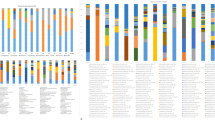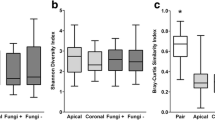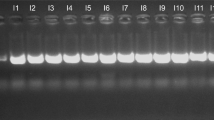Abstract
Objectives
To compare the root canal microbiome profiles of primary and persistent/secondary infections using high-throughput sequencing with the help of a reliable bioinformatics algorithm.
Materials and methods
Root canal samples of 10 teeth in the primary endodontic infection (PEI) group and 10 teeth in the persistent/secondary endodontic infection (SEI) group were included resulting in a total of 20 samples. After DNA extraction from the samples, sequencing was performed on the Illumina MiSeq platform. Pair-end Illumina reads were imported to QIIME 2; amplicon sequence variants (ASVs) generated by DADA2 were mapped to GreenGenes database. Weighted UniFrac distances were calculated and principal coordinates analysis (PCoA) was used to compare beta diversity patterns. The multiple response permutation procedure (MRPP), the analysis of similarities (ANOSIM), and permutational multivariate analysis of variance (adonis) were conducted for testing group differences. Linear discriminant analysis effect size (LEfSe) analysis was utilized to identify differentially abundant taxa between the groups. The linear discriminant analysis (LDA) score threshold was set to 4.0.
Results
Within the Gram-negative facultative anaerobic Gammaproteobacteria class outgroup, two orders (Pasteurellales, Vibrionales) and two families (Pasteurellaceae, Vibrionaceae) were significantly more abundant in the PEI group, whereas Gram-positive bacteria, Actinomycetales order, and Gram-positive anaerobic taxa, one genus (Olsenella) and one species (Olsenella uli), were identified as significantly more abundant in the SEI group.
Conclusions
A few taxa were differentially abundant within either the PEI or SEI group.
Clinical relevance
Reliable bioinformatic tools are needed to define microbial profiles of endodontic infections. Based on a limited number of samples, no distinct variation was determined between the bacterial diversity of initial and recurrent endodontic infections.




Similar content being viewed by others
Data Availability
The datasets generated during and/or analysed during the current study are not publicly available as consent for publication of raw data was not obtained from study participants, but are available from the corresponding author on reasonable request.
References
Kakehashi S, Stanley H, Fitzgerald R (1965) The effects of surgical exposures of dental pulps in germ-free and conventional laboratory rats. Oral Surg Oral Med Oral Pathol 20:340–349. https://doi.org/10.1016/0030-4220(65)90166-0
Signoretti FG, Gomes BP, Montagner F, Jacinto RC (2013) Investigation of cultivable bacteria isolated from longstanding retreatment-resistant lesions of teeth with apical periodontitis. J Endod 39:1240–1244. https://doi.org/10.1016/j.joen.2013.06.018
Ricucci D, Siqueira JF Jr (2010) Biofilms and apical periodontitis: study of prevalence and association with clinical and histopathologic findings. J Endod 36:1277–1288. https://doi.org/10.1016/j.joen.2010.04.007
Sundqvist G (1992) Associations between microbial species in dental root canal infections. Oral Microbiol Immunol 7:257–262. https://doi.org/10.1111/j.1399-302x.1992.tb00584.x
Siqueira JF Jr, Rôças IN (2009) Community as the unit of pathogenicity: an emerging concept as to the microbial pathogenesis of apical periodontitis. Oral Surg Oral Med Oral Pathol Oral Radiol Endod 107:870–878. https://doi.org/10.1016/j.tripleo.2009.01.044
Tzanetakis GN, Azcarate-Peril MA, Zachaki S, Panopoulos P, Kontakiotis EG, Madianos PN et al (2015) Comparison of bacterial community composition of primary and persistent endodontic infections using pyrosequencing. J Endod 41:1226–1233. https://doi.org/10.1016/j.joen.2015.03.010
Keskin C, Demiryürek EÖ, Onuk EE (2017) Pyrosequencing analysis of cryogenically ground samples from primary and secondary/persistent endodontic infections. J Endod 43:1309–1316. https://doi.org/10.1016/j.joen.2017.03.019
Bouillaguet S, Manoil D, Girard M, Louis J, Gaïa N, Leo S et al (2018) Root microbiota in primary and secondary apical periodontitis. Front Microbiol 2374. https://doi.org/10.3389/fmicb.2018.02374
Hong B-Y, Lee T-K, Lim S-M, Chang SW, Park J, Han SH et al (2013) Microbial analysis in primary and persistent endodontic infections by using pyrosequencing. J Endod 39:1136–1140. https://doi.org/10.1016/j.joen.2013.05.001
Amaral RR, Braga T, Siqueira JF Jr, Rôças IN, da Costa Rachid CTC, Oliveira AGG et al (2022) Root canal microbiome associated with asymptomatic apical periodontitis as determined by high-throughput sequencing. J Endod 48:487–495. https://doi.org/10.1016/j.joen.2022.01.012
Di Bella JM, Bao Y, Gloor GB, Burton JP, Reid G (2013) High throughput sequencing methods and analysis for microbiome research. J Microbiol Methods 95:401–414. https://doi.org/10.1016/j.mimet.2013.08.011
Delikan E, Caliskan S, Cankilic MY, Aksu S, Kesim B, Ulger ST (2021) Microbiota of endodontically infected primary and permanent teeth. Pediatr Dent 43:102–110
Tikhonov M, Leach RW, Wingreen NS (2015) Interpreting 16S metagenomic data without clustering to achieve sub-OTU resolution. ISME J 9:68–80. https://doi.org/10.1038/ismej.2014.117
Maruyama H, Masago A, Nambu T, Mashimo C, Okinaga T (2020) Amplicon sequence variant-based oral microbiome analysis using QIIME 2. J Osaka Dent Univ 54:273–281. https://doi.org/10.20944/preprints202008.0206.v1
Callahan BJ, McMurdie PJ, Holmes SP (2017) Exact sequence variants should replace operational taxonomic units in marker-gene data analysis. ISME J 11:2639–2643. https://doi.org/10.1038/ismej.2017.119
Prodan A, Tremaroli V, Brolin H, Zwinderman AH, Nieuwdorp M, Levin E (2020) Comparing bioinformatic pipelines for microbial 16S rRNA amplicon sequencing. PLoS One 15:e0227434. https://doi.org/10.1371/journal.pone.0227434
Nearing JT, Douglas GM, Comeau AM, Langille MG (2018) Denoising the denoisers: an independent evaluation of microbiome sequence error-correction approaches. PeerJ 6:e5364. https://doi.org/10.7717/peerj.5364
Callahan B, McMurdie P, Rosen M, Han A, Johnson AJA, Holmes SP (2016) DADA2: high-resolution sample inference from Illumina amplicon data. Nat Methods 13:581–583. https://doi.org/10.1038/nmeth.3869
Eren AM, Maignien L, Sul WJ, Murphy LG, Grim SL, Morrison HG et al (2013) Oligotyping: differentiating between closely related microbial taxa using 16S rRNA gene data. Methods Ecol Evol 4:1111–1119. https://doi.org/10.1111/2041-210x.12114
Eren AM, Morrison HG, Lescault PJ, Reveillaud J, Vineis JH, Sogin ML (2015) Minimum entropy decomposition: unsupervised oligotyping for sensitive partitioning of high-throughput marker gene sequences. ISME J 9:968–979. https://doi.org/10.1038/ismej.2014.195
Glassman SI, Martiny JB (2018) Broadscale ecological patterns are robust to use of exact sequence variants versus operational taxonomic units. MSphere 3:e00148-e218. https://doi.org/10.1128/msphere.00148-18
Demmer RT, Breskin A, Rosenbaum M, Zuk A, LeDuc C, Leibel R et al (2017) The subgingival microbiome, systemic inflammation and insulin resistance: the oral infections, glucose intolerance and insulin resistance study. J Clin Periodontol 44:255–265. https://doi.org/10.1111/jcpe.12664
Benahmed AG, Gasmi A, Doşa A, Chirumbolo S, Mujawdiya PK, Aaseth J et al (2021) Association between the gut and oral microbiome with obesity. Anaerobe 70:102248. https://doi.org/10.1016/j.anaerobe.2020.102248
Kuch A, Willems RJ, Werner G, Coque TM, Hammerum AM, Sundsfjord A, Sadowy E (2012) Insight into antimicrobial susceptibility and population structure of contemporary human Enterococcus faecalis isolates from Europe. J Antimicrob Chemother 67:551–558. https://doi.org/10.1093/jac/dkr544
Gomes BP, Pinheiro ET, Gadê-Neto CR, Sousa EL, Ferraz CC, Zaia AA, Souza-Filho FJ (2004) Microbiological examination of infected dental root canals. Oral Microbiol Immunol 19:71–76. https://doi.org/10.1046/j.0902-0055.2003.00116.x
Pourhajibagher M, Ghorbanzadeh R, Bahador A (2017) Culture-dependent approaches to explore the prevalence of root canal pathogens from endodontic infections. Braz Oral Res 31:e108. https://doi.org/10.1590/1807-3107bor-2017.vol31.0108
Sakamoto M, Rôças IN, Siqueira JF Jr, Benno Y (2006) Molecular analysis of bacteria in asymptomatic and symptomatic endodontic infections. Oral Microbiol Immunol 21:112–122. https://doi.org/10.1111/j.1399-302X.2006.00270.x
Sakamoto M, Siqueira JF Jr, Rôças IN, Benno Y (2008) Molecular analysis of the root canal microbiota associated with endodontic treatment failures. Oral Microbiol Immunol 23:275–281. https://doi.org/10.1111/j.1399-302X.2007.00423.x
Zandi H, Kristoffersen AK, Ørstavik D, Rôças IN, Siqueira JF Jr, Enersen M (2018) Microbial analysis of endodontic infections in root-filled teeth with apical periodontitis before and after irrigation using pyrosequencing. J Endod 44:372–378. https://doi.org/10.1016/j.joen.2017.11.019
Siqueira JF Jr, Alves FR, Rôças IN (2011) Pyrosequencing analysis of the apical root canal microbiota. J Endod 37:1499–1503. https://doi.org/10.1016/j.joen.2011.08.012
Ferrari PHP, Cai S, Bombana AC (2005) Effect of endodontic procedures on enterococci, enteric bacteria and yeasts in primary endodontic infections. Int Endod J 38:372–380. https://doi.org/10.1111/j.1365-2591.2005.00947.x
Anderson AC, Hellwig E, Vespermann R, Wittmer A, Schmid M, Karygianni L, Al-Ahmad A (2012) Comprehensive analysis of secondary dental root canal infections: a combination of culture and culture-independent approaches reveals new insights. PLoS One 7:e49576. https://doi.org/10.1371/journal.pone.0049576
Ersahan S, Hepsenoglu YE (2022) Microbial analysis of endodontic infections in teeth with post-treatment apical periodontitis before and after medication. Aust Endod J. https://doi.org/10.1111/aej.12613
Iweriebor BC, Obi LC, Okoh AI (2016) Macrolide, glycopeptide resistance and virulence genes in Enterococcus species isolates from dairy cattle. J Med Microbiol 65:641–648. https://doi.org/10.1099/jmm.0.000275
Hou Y, Wang L, Zhang L, Tan X, Huang D, Song D (2022) Potential relationship between clinical symptoms and the root canal microbiomes of root filled teeth based on the next-generation sequencing. Int Endod J 55:18–29. https://doi.org/10.1111/iej.13640
Nardello LC, Amado PP, Franco DC, Cazares RX, Nogales CG, Mayer MP et al (2020) Next-generation sequencing to assess potentially active bacteria in endodontic infections. J Endod 46:1105–1112. https://doi.org/10.1016/j.joen.2020.05.004
Hillman ET, Lu H, Yao T, Nakatsu CH (2017) Microbial ecology along the gastrointestinal tract. Microbes Environ 32:300–313. https://doi.org/10.1264/jsme2.me17017
Korona-Glowniak I, Piatek D, Fornal E, Lukowiak A, Gerasymchuk Y, Kedziora A et al (2021) Patterns of oral microbiota in patients with apical periodontitis. J Clin Med 10:2707. https://doi.org/10.3390/jcm10122707
Funding
This study was supported by the Nuh Naci Yazgan University Scientific Research Projects Department (project number: 2020-SA.DH-BP/13).
Author information
Authors and Affiliations
Corresponding author
Ethics declarations
Ethics approval
All procedures performed in this study involving human participants were approved by Mersin University Clinical Research Ethics Committee (Mersin, Turkey) (number 2020/359) and were carried out in accordance with the 1964 Helsinki Declaration and its later amendments or comparable ethical standards.
Informed consent
Informed consent was obtained from all individual participants included in the study.
Conflict of interest
The authors declare no competing interests.
Additional information
Publisher's note
Springer Nature remains neutral with regard to jurisdictional claims in published maps and institutional affiliations.
Supplementary Information
Rights and permissions
Springer Nature or its licensor (e.g. a society or other partner) holds exclusive rights to this article under a publishing agreement with the author(s) or other rightsholder(s); author self-archiving of the accepted manuscript version of this article is solely governed by the terms of such publishing agreement and applicable law.
About this article
Cite this article
Kesim, B., Ülger, S.T., Aslan, G. et al. Amplicon-based next-generation sequencing for comparative analysis of root canal microbiome of teeth with primary and persistent/secondary endodontic infections. Clin Oral Invest 27, 995–1004 (2023). https://doi.org/10.1007/s00784-023-04882-x
Received:
Accepted:
Published:
Issue Date:
DOI: https://doi.org/10.1007/s00784-023-04882-x






